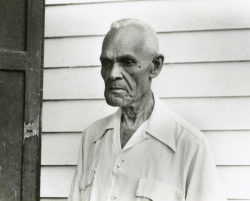Papa John Joseph
Papa John Joseph was a popular string bass player at Preservation Hall in New Orleans throughout the twentieth century.

Courtesy of Tulane University, William Ransom Hogan Archive of New Orleans Jazz
John "Papa" Joseph outside barber shop. Crawford, Ralston (Photographer)
Coming from a large musical family, “Papa” John Joseph was a New Orleans traditional jazz and early rhythm and blues (R&B) string bass player and multi-instrumentalist. Joseph was the elder brother of clarinetist Willie “Kaiser” Joseph and the granduncle of Don Vappie, the modern banjo virtuoso from New Orleans. Joseph died while performing on stage at New Orleans’s Preservation Hall in 1965.
Joseph was born on November 27, 1876, at Jamestown Landing, on the west bank of the Mississippi River in rural St. James Parish. He was born into a family of musicians, including his father, brothers, and mother, who played guitar and banjo. Early on, he became a member of the family band along with brother Nelson, two uncles, and bass and violin player Wellman Braud. His brother Willie, a clarinetist, was said to be the first member of the family to play a nonstringed instrument.
Joseph moved to New Orleans in 1906 and soon found work playing with artists like Pinchback Touro, Louis Dumaine, Louis James, Joe Johnson, Manual Manetta, and Buddy Petit. Joseph also worked as a barber at his shop on First Street and organized dances across the street, hiring musicians like King Oliver, Kid Ory, and John Robichaux to perform. In 1913 he left New Orleans to perform with a number of bands throughout the area, including the Holmes Band of Lutcher and the Claiborne Williams Band of Donaldsonville. For the next few decades his public performances would be infrequent.
The late 1940s to early 1950s saw the release of a number of early R&B anthologies, among them the well-regarded album The Chronological Smiley Lewis. Joseph played string bass on the recording, which featured the hits “I Hear You Knocking,” “Tee Nah Nah,” and “The Bells Are Ringin’.” In the 1950s Joseph was a strolling musician, playing often with artists like Edward “Noon” Johnson, Lemon Nash, and Punch Miller. Joseph’s gigs with Miller in the Associated Artists Gallery next to Pat O’Brien’s in the French Quarter were part of the stimulus that led to the formation of New Orleans’s famed Preservation Hall.
Joseph joined the musicians’ union for the first time at age eighty-six. This decade proved to be one of his most prolific, as he toured with Kid Sheik’s Storyville Ramblers, recorded for Atlantic Records in 1962, and toured Japan with George Lewis in 1963. After he returned to New Orleans he was a frequent and beloved Preservation Hall performer. He collapsed and died on January 22, 1965, at Preservation Hall, after a performance of “When the Saints Go Marching In.”
